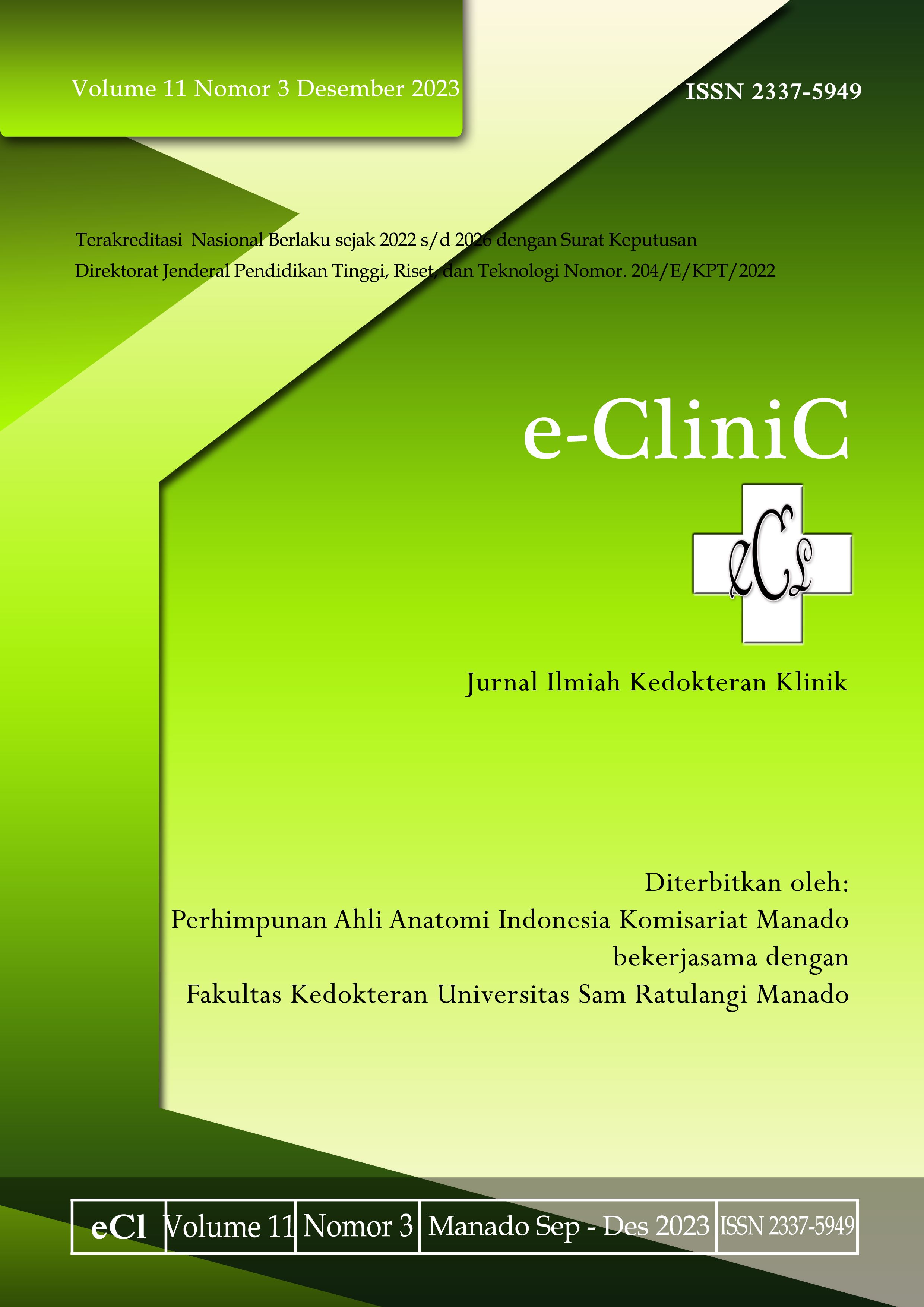Penanganan Rehabilitasi Medik pada Pasca Artrodesis Kaki Charcot Tanpa Komplikasi
DOI:
https://doi.org/10.35790/ecl.v11i3.44762Abstract
Impact of diabetes on the occurrence of Charcot's foot provides conservative treatment to the benefits of arthrodesis. Charcot foot is a debilitating joint disease characterized by progressive multiple bone destruction, dislocations, and severe deformities of the foot and ankle. Its prevalence may increase in the general high-risk population. Initial treatment of Charcot foot is often conservative and involves the use of bracing, casting, and special orthopedic shoes. This intervention allows the patient to functionally ambulate without resorting to more invasive interventions. Arthrodesis is an effective limb-saving method for patients with Charcot neuroarthropathy who have severe deformity and instability. This technique is usually used for chronic cases with irreversible deformity and/or joint instability to increase plantar pressure and balance of the foot and to minimize the risk of foot ulceration and amputation. In conclusion, non-weight bearing treatment dan immobilisation are the most effective rehabilitation management for active-phase Charcot foot accompanied by surgery consideration to maximize the functional of the foot.
Keywords: Charcot foot; diabetes; arthrodesis; rehabilitation management
Abstrak: Diabetes berdampak terhadap terjadinya kaki Charcot dengan penanganan secara konservatif hingga tindakan artrodesis. Kaki Charcot merupakan salah satu penyakit sendi yang merusak dan ditandai dengan progresifitas kerusakan tulang multipel, dislokasi dan deformitas parah pada kaki dan pergelangan kaki dengan prevalensi yang meningkat pada populasi dengan risiko tinggi. Perawatan awal kaki Charcot seringkali konservatif dan melibatkan penggunaan bracing, casting, dan sepatu ortopedi khusus. Intervensi ini memungkinkan pasien untuk ambulasi secara fungsional tanpa menggunakan intervensi yang lebih invasif. Artrodesis merupakan metode penyelamatan anggota tubuh yang efektif untuk pasien dengan neuropati Charcot yang memiliki deformitas parah dan ketidakstabilan. Teknik ini biasanya digunakan untuk kasus kronis dengan deformitas ireversibel dan/atau ketidakstabilan sendi untuk meningkatkan tekanan dan keseimbangan plantar kaki dan untuk meminimalkan risiko ulserasi dan amputasi kaki. Simpulan studi ini ialah penanganan non-weight bearing dan imobilisasi merupakan penanganan rehabilitasi untuk kaki Charcot fase aktif dengan pertimbangan tindakan pembedahan untuk memaksimalkan fungsi kaki.
Kata kunci: kaki Charcot; diabetes; arthrodesis; penanganan rehabilitasi
References
Pinzur MS. An evidence-based introduction to charcot foot arthropathy. Loyola University Health System: Foot & Ankle Orthopaedics. 2018:1-7. Doi: 10.1177/2473011418774269
Brockett CL, Chapman GJ. Biomechanics of the ankle. United Kingdom: Elsevier; 2016.
Kucera T, Shaikh HH, Sponer P. Charcot neuropathic arthropathy of the foot: a literature review and single-center experience. Czech Republic. J Diab Res. 2016;2016:3207043. Available from http://dx.doi. org/10.1155/2016/3207043
Idusuyi OB. Surgical management of charcot neuroarthropathy. Prosthetics and orthotics international. USA. Prosthet Orthot Int. 2015;39(I):61-72. Doi: 10.1177/0309364614560939
Griffiths DA, Kaminski MR. Duration of total contact casting for resolution of acute Charcot foot: a retrospective cohort study. J Foot Ankle Res. 2021;14(1):44. Available from: https://doi.org/ 10.1186/s13047-021-00477-5
Safavi PS, Jupiter D, Panchbhavi V. A systematic review of current surgical interventions for charcot neuroarthropathy of the midfoot. The Journal of Foot & Ankle Surgery. 2017:1-4. Available from: https://doi.org/10.1053/j.jfas.2017.06.011.
Wang Y, Zhou J, Yan F, Li G, Duan X, Pan H, et al. Comparison of arthrodesis with total contact casting for midfoot ulcerations associated with Charcot neuroarthropathy. Med Sci Monit. 2015;21: 2141-8.
Lippert LS. Anatomy and Kinesiology (5th ed). Philadelphia: F.A Davis Company; 2011.
Dhillon S, Dhillon MS, Arumugam S, Gowda PK, Chabbra M, Kumar P. Foot biomechanics and relation to the gait cycle. J Foot Ankle Surg (Asia Pacific) (JFAS-AP). 2018;5(2):68-72.
Crew MS, Wrobel JS. Physical management of the charcot foot. Clin Podiatr Med Surg. 2008;25(1):71–9. Doi: 10.1016/j.cpm.2007.10.009
Kimmerle R, Chantelau E. Weight-bearing intensity produces charcot deformity in injured neuropathic feet in diabetes. Exp Clin Endocrinol Diabetes. 2007;115(6):360-4. Doi: 10.1055/s-2007-970578
Lowery NJ, Woods JB, Amstrong DG, Wukich DK. Surgical management of Charcot neuroarthropathy of the foot and ankle: a systematic review. Foot Ankle Int. 2012;33((2):113-21. Doi: 10.3113/FAI.2012.0113.
Kavarthapu V, Alexandros V. Charcot midfoot reconstruction—surgical technique based on deformity patterns. Ann Joint. 2020;5:28.
Galhoum AE, Ella MMA. Charcot ankle neuroarthropathy pathology, diagnosis and management: a review of literature. MOJ Orthopedics and Rheumatology. 2016;6(2):00218. Doi: 10.15406/ mojor.2016.06.00218
Rogers LC, Frykberg RG, Amstrong DG, Boulton AJM, Edmonds M, Van GH, et al. The Charcot foot in diabetes. Diab Care. 2011;34(9):2123_9. Doi: 10.2337/dc11-0844
Ramanujam CL, Zgonis T. Stepwise approach to Charcot midfoot reconstruction and external fixation. Diabetic Foot & Ankle. 2016;7:27751. Doi: 10.3402/dfa.v7.27751
Chraim M, Krenn S, Alrabai HM, Trnka HJ, Bock P. Mid-term follow-up of patients with hindfoot arthrodesis with retrograde compression intramedullary nail in Charcot neuroarthropathy of the hindfoot. Bone Joint J. 2018;100-B(@):190-6. Doi:10.1302/0301-620X.100B2
Milne TE, Rogers JR, Kinnear EM, Martin HV, Lazzarini PA, Quinton TR, et al. Developing an evidence-based clinical pathway for the assessment, diagnosis and management of acute Charcot neuro-arthropathy: a systematic review. J Foot Ankle Res (JFAR). 2013;6(1):30. Doi: 10.1186/ 1757-1146-6-30.
Verity S, Sochocki M, Embil JM, Trepman E. Treatment of Charcot foot and ankle with a prefabricated removable walker brace and custom insole. Foot Ankle Surg. 2008;14(1):26–31. Doi: 10.1016/ j.fas.2007.10.002
Downloads
Published
How to Cite
Issue
Section
License
Copyright (c) 2023 Christina A. Damopolii, Joudy Gessal, Devan Perwira

This work is licensed under a Creative Commons Attribution-NonCommercial 4.0 International License.
COPYRIGHT
Authors who publish with this journal agree to the following terms:
Authors hold their copyright and grant this journal the privilege of first publication, with the work simultaneously licensed under a Creative Commons Attribution License that permits others to impart the work with an acknowledgment of the work's origin and initial publication by this journal.
Authors can enter into separate or additional contractual arrangements for the non-exclusive distribution of the journal's published version of the work (for example, post it to an institutional repository or publish it in a book), with an acknowledgment of its underlying publication in this journal.
Authors are permitted and encouraged to post their work online (for example, in institutional repositories or on their website) as it can lead to productive exchanges, as well as earlier and greater citation of the published work (See The Effect of Open Access).







